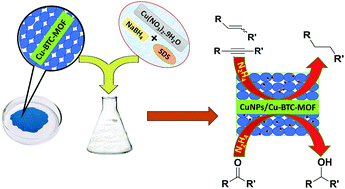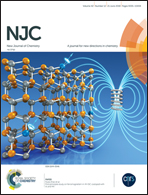An efficient and sustainable catalytic reduction of carbon–carbon multiple bonds, aldehydes, and ketones using a Cu nanoparticle decorated metal organic framework†
Abstract
Transition metal (Cu, Mn, Ni, Zr) substituted metal organic frameworks (MOFs) are prepared for the reduction of carbon–carbon multiple bonds with hydrazine hydrate in ethanol under mild reaction conditions. Among the MOFs investigated in this study, the Cu framework substituted MOF exhibited the best activity in this study. Further, Cu nanoparticles (CuNPs) are supported on the surface of a Cu framework substituted MOF to achieve excellent reduction activity. The catalyst exhibits efficient recyclability with no appreciable loss in the catalytic activity even after five recycles. In order to establish the reaction mechanism, reactions are performed under N2 and Ar atmospheres. A reaction is also performed under an Ar atmosphere but in the presence of H2O2 to elucidate the mechanism. The catalyst exhibits excellent activity in the reduction of alkynes. Under the optimum reaction conditions, the catalyst is also successful in reducing a wide range of aldehydes and ketones. The present catalytic process demonstrates several key advantages such as mild and convenient reaction conditions, a low substrate to hydrazine ratio, reusability, and cost-effectiveness of the catalyst (Pt or Pd free catalyst).



 Please wait while we load your content...
Please wait while we load your content...